Buying a subwoofer and amplifier is like going shopping. You have to make sure that clothes you buy fit you well, else it’s a complete waste.
Matching your subwoofer to your amplifier is essential to make sure that there is no downgrading when it comes to sound output quality or any damage to the subwoofer.
The market is flooded with a plethora of options, including 15-inch car subwoofers that you can see by Clicking Here.
However, it can be overwhelming when it comes to selecting the right choices.
But the problem can be solved if we pay attention to a few critical points.
1. Checking the RMS rating
RMS rating also known as Root Mean Square Power Rating of an amplifier tells you how much power it can sustain.
The power is generated in the form of heat and vibration, and the maximum value indicates the amount of power which can be sustained without damaging the coil.
One must be careful to not confuse RMS rating with that of maximum power, which indicates a maximum resilience to burst of power.
RMS tells us about the power figure which can be sustained over a long duration.
The rule of thumb is to make sure that the power rating of your amplifier is between 0.9 to 1.2 times of power rating of your subwoofer.
It is a good practice to go for an amplifier with a higher power rating than the one calculated, as it gives you more headroom. This ensures that there is less heat exposure and coils aren’t damaged.
Under-powering your amplifier will lead to subpar audio quality, distortion and can permanently damage your subwoofer system.
2. Impedance
The impedance of an electrical instrument is technically defined as the resistance it offers to the flow of current across its terminals.
While connecting your amplifier and subwoofer, it is important to match them. Now matching them doesn’t always necessarily means having the same value.
For example, in the case of a single subwoofer system, one needs to make sure that the amplifier and subwoofer have the same rating.
But most cars come with a dual subwoofer system, so the amplifier must satisfy the resistance need of each subwoofer. In the case of a dual subwoofer system, the amplifier’s impedance must be twice to that of the subwoofers.
The same calculation can be done in the case of multi-subwoofer systems.
Using a low impedance amplifier can distort sound and permanent damage to the subwoofer system. Some subwoofer may shut down as a protective measure.
3. Channels
In simple words, a channel is just an amplifier outlet which distributes frequency and impedance to the speakers connected with it.
A car amplifier can have a maximum of 6 amplifiers.
However, the most recommended ones are the monoblock or single channel connected to a subwoofer system.
Multiple subwoofers can be connected to a single channel. This setup means the output frequency is equally distributed to the individual subwoofer.
Since the primary use of a subwoofer is to play low-frequency sound, a single channel setup is more efficient for the overall audio experience.
Using multiple channel amplifiers can limit power output, impedance, which leads to a non-optimized subwoofer system.
4. Enclosure
Enclosures are one key component which most people don’t pay attention to. But they are more than just a designing component.
Enclosure’s quality influences the overall sound output to a large extent.
There are primarily two kinds of enclosures- sealed enclosure and ported enclosure. Each one of them has their specific functionality.
Sealed Enclosure has better amplifiers. They give a more crisp and tight bass sound. Another advantage of a sealed enclosure is its relatively small size when compared with a portable one.
The downside of using a sealed enclosure is a relatively higher consumption of power to play louder bass.
On the other hand, ported enclosure gives you a very loud sound level but a less accurate bass sound.
Ported enclosure takes up a larger space but doesn’t require much power to operate.
Both of them are reasonable options, and you should go for the one according to your preference and space availability in your car.
These were some key points into matching your amplifier with a subwoofer.
However, there are a few minor details which you should cross check before buying one.
5. CEA compliance is a necessity for any audio products
Though almost every branded product come with the compliance, it’s a good practice to check once before making the purchase.
6. Amplifier size
As a general rule, if your car is 5 meters long and you don’t prefer a loud music output, a 400 watts amplifier is enough to suffice your needs.
Go for a complicated setup only if you want more output.
Conclusion
Matching a subwoofer to your amplifier isn’t as complicated it might seem like.
If you have a large car and prefer a loud output, then we should suggest going for some the best 15-inch car subwoofer.
Read Also:




























